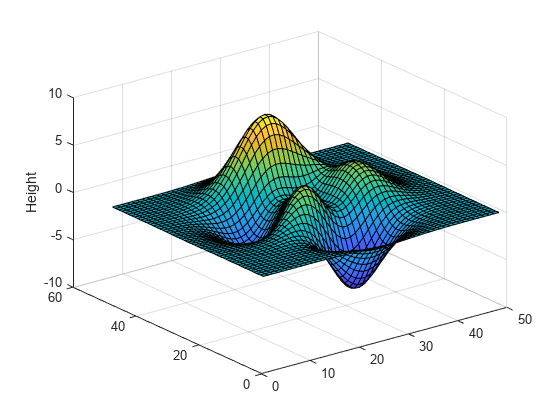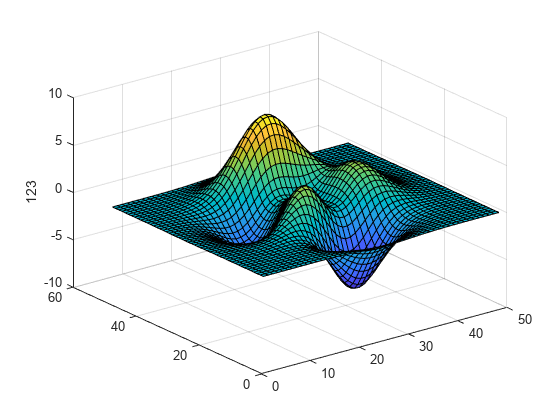zlabel
z축에 레이블 지정하기
설명
zlabel(는 하나 이상의 txt,Name,Value)Name,Value 쌍의 인수를 사용하여 text 객체 속성을 추가로 지정합니다.
zlabel(는 ax,___)ax로 지정된 좌표축에 레이블을 추가합니다. 이 구문을 사용하면 레이블을 추가할 좌표축을 지정할 수 있습니다. ax는 위에 열거된 구문의 입력 인수 조합보다 먼저 나올 수 있습니다.
h = zlabel(___)
예제
여러 라인으로 된 셀형 배열을 사용하여 여러 라인으로 구성된 레이블을 만듭니다.
figure
surf(peaks)
zlabel({'First Line';'Second Line'})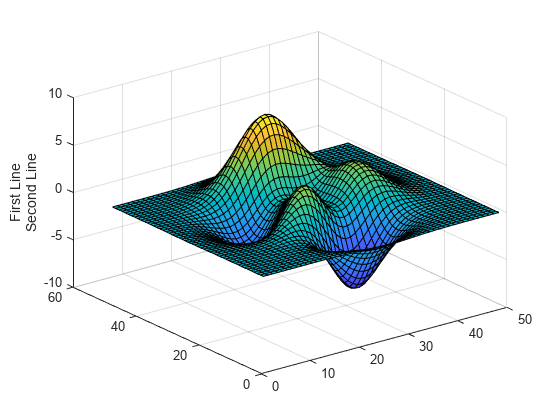
Name,Value 쌍을 사용하여 z축 레이블의 글꼴 크기, 글꼴 두께, 텍스트 색 속성을 설정합니다.
figure surf(peaks) zlabel('Elevation','FontSize',12,... 'FontWeight','bold','Color','r')
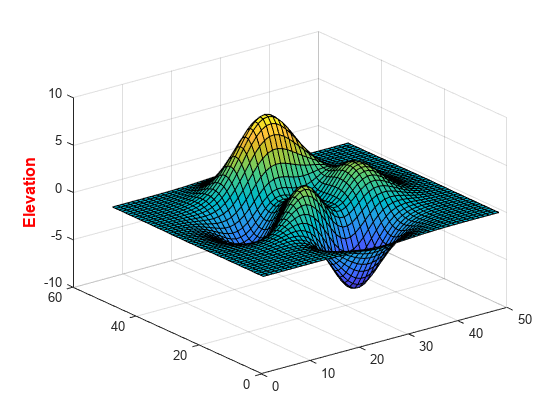
'FontSize',12는 레이블 텍스트를 12포인트 글꼴로 표시합니다. 'FontWeight','bold'는 텍스트를 굵게 표시합니다. 'Color','r'은 텍스트 색을 빨간색으로 설정합니다.
R2019b부터는 tiledlayout 함수와 nexttile 함수를 사용하여 플롯을 타일 형식 배열로 표시할 수 있습니다. tiledlayout 함수를 호출하여 2×1 타일 형식 차트 레이아웃을 만듭니다. nexttile 함수를 호출하여 axes 객체 ax1과 ax2를 만듭니다. 두 개의 곡면 플롯을 만들고, ax2를 zlabel에 대한 첫 번째 입력 인수로 지정하여 두 번째 플롯에 z축 레이블을 추가합니다.
tiledlayout(2,1)
ax1 = nexttile;
surf(ax1,peaks(30))
ax2 = nexttile;
surf(ax2,peaks(45))
zlabel(ax2,'Height')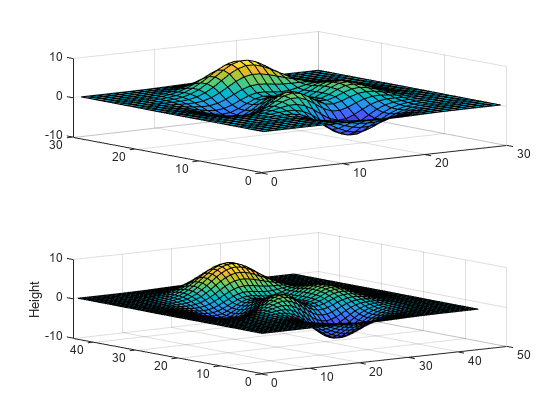
z축에 레이블을 지정한 후 레이블로 사용된 text 객체를 반환합니다.
surf(peaks)
t = zlabel('Population Change');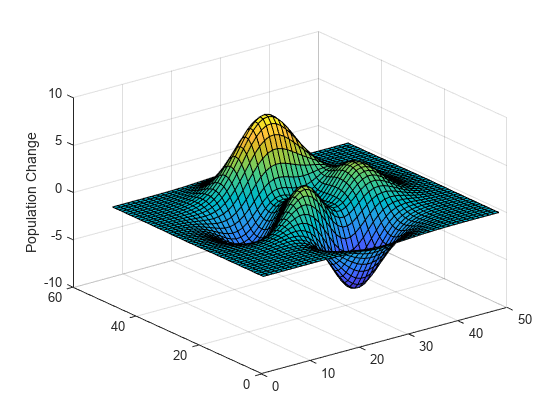
레이블의 색을 빨간색으로 설정합니다. 점 표기법을 사용하여 속성을 설정합니다.
t.Color = 'red';
입력 인수
축 레이블로, string형 스칼라, 문자형 벡터, string형 배열, 문자형 배열, 셀형 배열, categorical형 배열 또는 숫자형 값으로 지정됩니다.
예: 'my label'
예: {'first line','second line'}
예: 123
레이블에 텍스트와 함께 숫자형 변수를 포함시키려면 num2str 함수를 사용하십시오. 예를 들면 다음과 같습니다.
x = 42;
txt = ['The value is ',num2str(x)];위 첨자, 아래 첨자, 그리스 문자, 숫자 기호 등의 특수 문자를 포함시키려면 TeX 마크업을 사용하십시오. 지원되는 마크업의 목록을 보려면 Interpreter 속성을 참조하십시오.
여러 라인으로 구성된 레이블을 만들려면 다음을 수행하십시오.
string형 배열을 사용합니다. 여기서 각 요소에는 한 라인의 텍스트가 포함되어 있습니다(예:
["first line","second line"]).셀형 배열을 사용합니다. 여기서 각 셀에는 한 라인의 텍스트가 포함되어 있습니다(예:
{'first line','second line'}).문자형 배열을 사용합니다. 여기서 각 행에는 동일한 문자 수가 포함되어 있습니다(예:
['abc'; 'ab ']).sprintf를 사용하여 새 줄(Newline) 문자가 포함된 텍스트를 만듭니다(예:sprintf('first line \n second line')).
숫자형 레이블은 sprintf('%g',value)를 사용하여 텍스트로 변환됩니다. 예를 들어, 12345678은 1.23457e+07로 표시됩니다.
참고
레이블을 categorical형 배열로 지정할 경우 MATLAB®은 배열의 범주가 아닌 배열의 값을 사용합니다.
default,factory,remove와 같은 단어는 예약어이므로 일반 문자처럼 따옴표로 묶으면 레이블에 표시되지 않습니다. 이 단어들을 개별적으로 표시하려면'\default','\remove'와 같이 단어 앞에 백슬래시를 추가하십시오.
대상 좌표축으로, Axes 객체 또는 Axes 객체로 구성된 배열로 지정됩니다.
이 인수를 지정하지 않는 경우 zlabel은 현재 좌표축을 수정합니다.
이름-값 인수
선택적 인수 쌍을 Name1=Value1,...,NameN=ValueN으로 지정합니다. 여기서 Name은 인수 이름이고 Value는 대응값입니다. 이름-값 인수는 다른 인수 뒤에 와야 하지만, 인수 쌍의 순서는 상관없습니다.
R2021a 이전 릴리스에서는 쉼표를 사용하여 각 이름과 값을 구분하고 Name을 따옴표로 묶으십시오.
예: 'Color','red','FontSize',12는 빨간색, 12포인트 글꼴을 지정합니다.
Name,Value 쌍의 인수를 사용하여 다음 속성뿐만 아니라 다른 text 객체 속성을 지정할 수 있습니다. Text 속성를 참조하십시오.
글꼴 크기로, 0보다 큰 스칼라 값으로 지정됩니다(단위: 포인트). 1포인트는 1/72인치와 같습니다. 글꼴 단위를 변경하려면 FontUnits 속성을 사용하십시오.
연관 좌표축의 글꼴 크기 속성을 설정하면 레이블 글꼴 크기에도 영향을 미칩니다. 레이블 스케일링 인자에 좌표축 글꼴 크기를 곱한 값으로 레이블 글꼴 크기가 업데이트됩니다. 좌표축의 FontSize 속성에는 좌표축 글꼴 크기가 포함됩니다. 좌표축의 LabelFontSizeMultiplier 속성에는 레이블 스케일링 인자가 포함됩니다. 기본적으로, 좌표축 글꼴 크기는 10포인트이고 스케일링 인자는 1.1이므로 z축의 레이블 글꼴 크기는 11포인트가 됩니다.
데이터형: single | double | int8 | int16 | int32 | int64 | uint8 | uint16 | uint32 | uint64
문자 두께로, 'normal' 또는 'bold'로 지정됩니다.
MATLAB은 FontWeight 속성을 사용하여 사용자의 시스템에서 사용 가능한 글꼴 중 하나를 선택합니다. 모든 글꼴에 굵은 두께가 있는 것은 아닙니다. 따라서 굵은 글꼴 두께를 지정해도 보통 글꼴 두께로 보일 수 있습니다.
글꼴 이름으로, 지원되는 글꼴 이름 또는 "FixedWidth"로 지정됩니다. 텍스트를 정상적으로 표시하고 인쇄하려면 사용자의 시스템에서 지원하는 글꼴을 선택해야 합니다. 디폴트 글꼴은 운영 체제와 로캘에 따라 다릅니다.
모든 로캘에서 미려하게 표시되는 고정 너비 글꼴을 사용하려면 "FixedWidth"를 사용하십시오. 고정 너비 글꼴은 루트 FixedWidthFontName 속성에 따라 달라집니다. 루트 FixedWidthFontName 속성을 설정하면 새 글꼴을 사용하도록 디스플레이가 즉시 업데이트됩니다.
텍스트 색으로, RGB 3색, 16진수 색 코드, 색 이름 또는 짧은 이름으로 지정됩니다.
사용자 지정 색의 경우에는 RGB 3색 또는 16진수 색 코드를 지정하십시오.
RGB 3색은 요소를 3개 가진 행 벡터로, 각 요소는 색을 구성하는 빨간색, 녹색, 파란색의 농도를 지정합니다. 농도의 범위는
[0,1]이어야 합니다(예:[0.4 0.6 0.7]).16진수 색 코드는 string형 스칼라 또는 문자형 벡터로, 해시 기호(
#)로 시작하고 그 뒤에 3자리 또는 6자리의 16진수 숫자(0에서F사이일 수 있음)가 옵니다. 이 값은 대/소문자를 구분하지 않습니다. 따라서 색 코드"#FF8800","#ff8800","#F80"및"#f80"은 모두 동일합니다.
몇몇의 흔한 색은 이름으로 지정할 수도 있습니다. 다음 표에는 명명된 색 옵션과 그에 해당하는 RGB 3색 및 16진수 색 코드가 나와 있습니다.
| 색 이름 | 짧은 이름 | RGB 3색 | 16진수 색 코드 | 모양 |
|---|---|---|---|---|
"red" | "r" | [1 0 0] | "#FF0000" |
|
"green" | "g" | [0 1 0] | "#00FF00" |
|
"blue" | "b" | [0 0 1] | "#0000FF" |
|
"cyan" | "c" | [0 1 1] | "#00FFFF" |
|
"magenta" | "m" | [1 0 1] | "#FF00FF" |
|
"yellow" | "y" | [1 1 0] | "#FFFF00" |
|
"black" | "k" | [0 0 0] | "#000000" |
|
"white" | "w" | [1 1 1] | "#FFFFFF" |
|
"none" | 해당 없음 | 해당 없음 | 해당 없음 | 색 없음 |
다음 표에는 라이트 테마와 다크 테마에서 플롯의 디폴트 색 팔레트가 나열되어 있습니다.
| 팔레트 | 팔레트 색 |
|---|---|
R2025a 이전: 대부분의 플롯은 기본적으로 이 색을 사용합니다. |
|
|
|
orderedcolors 함수와 rgb2hex 함수를 사용하여 이러한 팔레트의 RGB 3색과 16진수 색 코드를 가져올 수 있습니다. 예를 들어, "gem" 팔레트의 RGB 3색을 가져와서 16진수 색 코드로 변환해 보겠습니다.
RGB = orderedcolors("gem");
H = rgb2hex(RGB);R2023b 이전: RGB = get(groot,"FactoryAxesColorOrder")를 사용하여 RGB 3색을 가져옵니다.
R2024a 이전: H = compose("#%02X%02X%02X",round(RGB*255))를 사용하여 16진수 색 코드를 가져옵니다.
예: 'blue'
예: [0 0 1]
예: '#0000FF'
텍스트 방향으로, 스칼라 값(단위: 도)으로 지정됩니다. 회전 값이 0도이면 텍스트가 가로 방향으로 놓입니다. 세로 방향 텍스트를 만들려면 이 속성을 90도나 -90도로 설정하십시오. 양의 값은 텍스트를 시계 반대 방향으로 회전시킵니다. 음의 값은 텍스트를 시계 방향으로 회전시킵니다.
데이터형: single | double | int8 | int16 | int32 | int64 | uint8 | uint16 | uint32 | uint64
텍스트 인터프리터로, 다음 값 중 하나로 지정됩니다.
'tex'— TeX 마크업의 서브셋을 사용하여 문자를 해석합니다.'latex'— LaTeX 마크업을 사용하여 문자를 해석합니다.'none'— 리터럴 문자를 표시합니다.
TeX 마크업
기본적으로 MATLAB은 TeX 마크업의 서브셋을 지원합니다. TeX 마크업을 사용하여 위 첨자와 아래 첨자를 추가하고, 글꼴 유형과 색을 수정하며, 텍스트에 특수 문자를 포함시킬 수 있습니다.
수정자는 텍스트의 끝까지 적용됩니다. 단, 위 첨자와 아래 첨자는 바로 다음에 오는 문자나 중괄호 안에 있는 문자만 수정합니다. 인터프리터를 "tex"으로 설정한 경우 지원되는 수정자는 다음과 같습니다.
| 수정자 | 설명 | 예 |
|---|---|---|
^{ } | 위 첨자 | "text^{superscript}" |
_{ } | 아래 첨자 | "text_{subscript}" |
\bf | 굵은 글꼴 | "\bf text" |
\it | 기울임꼴 | "\it text" |
\sl | 오블리크 글꼴(일반적으로 기울임꼴과 같음) | "\sl text" |
\rm | 보통 글꼴 | "\rm text" |
\fontname{ | 글꼴 이름 — | "\fontname{Courier} text" |
\fontsize{ | 글꼴 크기 — | "\fontsize{15} text" |
\color{ | 글꼴 색 — red, green, yellow, magenta, blue, black, white, gray, darkGreen, orange, lightBlue 색 중 하나로 바꿉니다. | "\color{magenta} text" |
\color[rgb]{specifier} | 사용자 지정 글꼴 색 — | "\color[rgb]{0,0.5,0.5} text" |
다음 표에는 "tex" 인터프리터에 사용할 수 있는 특수 문자가 나열되어 있습니다.
| 문자 시퀀스 | 기호 | 문자 시퀀스 | 기호 | 문자 시퀀스 | 기호 |
|---|---|---|---|---|---|
| α |
| υ |
| ~ |
| ∠ |
| ϕ |
| ≤ |
|
|
| χ |
| ∞ |
| β |
| ψ |
| ♣ |
| γ |
| ω |
| ♦ |
| δ |
| Γ |
| ♥ |
| ϵ |
| Δ |
| ♠ |
| ζ |
| Θ |
| ↔ |
| η |
| Λ |
| ← |
| θ |
| Ξ |
| ⇐ |
| ϑ |
| Π |
| ↑ |
| ι |
| Σ |
| → |
| κ |
| ϒ |
| ⇒ |
| λ |
| Φ |
| ↓ |
| µ |
| Ψ |
| º |
| ν |
| Ω |
| ± |
| ξ |
| ∀ |
| ≥ |
| π |
| ∃ |
| ∝ |
| ρ |
| ∍ |
| ∂ |
| σ |
| ≅ |
| • |
| ς |
| ≈ |
| ÷ |
| τ |
| ℜ |
| ≠ |
| ≡ |
| ⊕ |
| ℵ |
| ℑ |
| ∪ |
| ℘ |
| ⊗ |
| ⊆ |
| ∅ |
| ∩ |
| ∈ |
| ⊇ |
| ⊃ |
| ⌈ |
| ⊂ |
| ∫ |
| · |
| ο |
| ♣ |
| ¬ |
| ∇ |
| ⌊ |
| x |
| ... |
| ⊥ |
| √ |
| ´ |
| ∧ |
| ϖ |
| ∅ |
| ⌉ |
| 〉 |
| | |
| ∨ |
| 〈 |
| © |
LaTeX 마크업
LaTeX 마크업을 사용하려면 인터프리터를 "latex"으로 설정하십시오. 인라인 모드의 경우 마크업을 단일 달러 기호($)로 묶으십시오. 디스플레이 모드의 경우 마크업을 이중 달러 기호($$)로 묶으십시오.
| LaTeX 모드 | 예 | 결과 |
|---|---|---|
| 인라인 |
"$\int_1^{20} x^2 dx$" |
|
| 표시 |
"$$\int_1^{20} x^2 dx$$" |
|
표시되는 텍스트에 디폴트 LaTeX 글꼴 스타일이 사용됩니다. FontName, FontWeight, FontAngle 속성은 영향을 미치지 않습니다. 글꼴 스타일을 변경하려면 LaTeX 마크업을 사용하십시오.
LaTeX 인터프리터와 함께 사용할 수 있는 최대 텍스트 크기는 1,200자입니다. 여러 라인으로 된 텍스트의 경우에는 라인당 약 10자씩 줄어듭니다.
MATLAB은 대부분의 표준 LaTeX 수식 모드 명령을 지원합니다. 자세한 내용은 지원되는 LaTeX 명령 항목을 참조하십시오. TeX 및 LaTeX을 사용하는 예제는 차트 텍스트에 들어 있는 그리스 문자나 특수 문자 항목을 참조하십시오.
출력 인수
z축 레이블로 사용되는 text 객체입니다. 레이블이 생성된 후에 레이블의 속성에 액세스하여 수정하려면 h를 사용하십시오.
팁
기본적으로
Interactions속성은editInteraction을 포함하므로, 텍스트를 클릭하여 텍스트를 편집할 수 있습니다. 이 상호 작용을 비활성화하려면 text 객체의Interactions속성을[]로 설정하십시오.
버전 내역
R2006a 이전에 개발됨
MATLAB Command
You clicked a link that corresponds to this MATLAB command:
Run the command by entering it in the MATLAB Command Window. Web browsers do not support MATLAB commands.
웹사이트 선택
번역된 콘텐츠를 보고 지역별 이벤트와 혜택을 살펴보려면 웹사이트를 선택하십시오. 현재 계신 지역에 따라 다음 웹사이트를 권장합니다:
또한 다음 목록에서 웹사이트를 선택하실 수도 있습니다.
사이트 성능 최적화 방법
최고의 사이트 성능을 위해 중국 사이트(중국어 또는 영어)를 선택하십시오. 현재 계신 지역에서는 다른 국가의 MathWorks 사이트 방문이 최적화되지 않았습니다.
미주
- América Latina (Español)
- Canada (English)
- United States (English)
유럽
- Belgium (English)
- Denmark (English)
- Deutschland (Deutsch)
- España (Español)
- Finland (English)
- France (Français)
- Ireland (English)
- Italia (Italiano)
- Luxembourg (English)
- Netherlands (English)
- Norway (English)
- Österreich (Deutsch)
- Portugal (English)
- Sweden (English)
- Switzerland
- United Kingdom (English)
